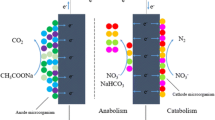Abstract
In this study, a novel nitrate reduction method using an electro-enzymatic system was investigated to treat an aqueous solution containing high concentrations of nitrate. This system was comprised of working electrodes and their counter electrodes, where enzymes for nitrate removal were located inside the microorganisms. A nitrate reduction mechanism for the electro-enzymatic system was proposed and a mathematical model was developed. The modeling results were compared to the experimental results and all the experimental results fit well with the model; thus, the derived mathematical model can be used for reactor control and effluent prediction.
Similar content being viewed by others
References
Keith, L. H. and W. A. Telliard (1979) Priority pollutants. I-a perspective view. Special report. Environ. Sci. Technol. 13: 416–423.
Mirvish, S. S. (1977) N-nitroso compounds, nitrite and nitrate: Possible implications for the causation of human cancer. J. Water Pollut. 8: 195–207.
Winton, E. F. (1971) Nitrate in drinking water. J. AWWA 63: 95–103.
Gonzalez, P. J., C. Correia, I. Moura, C. D. Brondino, and J. J. G. Moura (2006) Bacterial nitrate reductases: Molecular and biological aspects of nitrate reduction. J. Inorg. Biochem. 100: 1015–1023.
Berks, B. C., S. J. Ferguson, J. W. B. Moir, and D. J. Richardson (1995) Enzymes and associated electron transport systems that catalyse the respiratory reduction of nitrogen oxides and oxyanions. Biochim. Biophys. Acta. 1232: 97–173.
Zumft, W. G. (1997) Cell biology and molecular basis of denitrification. Microbiol. Mol Biol. Rev. 61: 533–616.
Chopin, A., V. Biaudet, and S. D. Ehrlich (1998) Definition and distinction between assimilatory, dissimilatory and respiratory pathways. Mol. Microbiol. 29: 664–666.
Moreno-Vivian, C., P. Cabello, M. Martinez-Luque, R. Blasco, and F. Castillo (1999) Prokaryotic nitrate reduction: Molecular properties and functional distinction among bacterial nitrate reductases. J. Bacteriol. 181: 6573–6584.
Richardson, D. J. and N. J. Watmough (1999) Inorganic nitrogen metabolism in bacteria. Curr. Opin. Chem. Biol. 3: 207–219.
Tavares, P., A. S. Pereira, J. J. G. Moura, and I. Moura (2006) Metalloenzymes of the denitrification pathway. J. Biol. Inorg. Chem. 100: 2087–2100.
Takayama, K. (1998) Biocatalyst electrode modified with wholecells of P. denitrificans for the determination of nitrate. Bioelectrochem. Bioenerg. 45: 67–72.
Cast, K. L. and J. R. V. Flora (1998) An evolution of two cathode materials and the impact of copper on bio-electrochemical denitrification. Water Res. 32: 63–70.
Watanabe, T., H. Motoyama, and M. Kuroda (2001) Denitrification and neutralization treatment by direct feeding of an acidic wastewater containing copper ion and high-strength nitrate to a bio-electrochemical reactor process. Water Res. 35: 4102–4110.
Choi, K. O., S. H. Song, and Y. J. Yoo (2004) Permeabilization of Ochrobactrum anthropi SY509 cells with organic solvents for whole cell biocatalyst. Biotechnol. Bioproc. Eng. 9: 147–150.
Choi, K. O., S. H. Song, Y. H. Kim, D. H. Park and Y. J. Yoo (2006) Bioelectrochemical denitrification using permeabilized Ochrobactrum anthropi SY509 J Microbiol. Biotechnol. 16: 678–682.
Kim, Y. H., Y. J. Park, S. H. Song, and Y. J. Yoo (2007) Nitrate removal without carbon source feeding by permeabilized Ochrobactrum anthropi SY509 using an electrochemical bioreactor. Enz. Microb. Technol. 41: 663–668.
Cho, J. S., J. Y. Park, and Y. J. Yoo (2008) Novel 3-dimensional bioelectrode for mediatorless bioelectrochemical denitrification. Biotechnol. Lett. 30: 1617–1620.
Song, S. H., S. H. Yeom, S. S. Choi, and Y. J. Yoo (2002) Effect of aeration on denitrification by Ochrobactrum anthropi SY509. Biotechnol. Bioproc. Eng. 7: 352–356.
Gonzalez, P. J., C. Correia, I. Moura, C. D. Brondino, and J. J. G. Moura (2006) Bacterial nitrate reductases: Molecular and biological aspects of nitrate reduction. J. Inorg. Biochem. 100: 1015–1023.
Godber, B. L. J., J. J. Doel, T. A. Goult, R. Eisenthal, and R. Harrison (2001) Suicide inactivation of xanthine oxidoreductase during reduction of inorganic nitrite to nitric oxide. Biochem. J. 358: 325–333.
Author information
Authors and Affiliations
Corresponding author
Rights and permissions
About this article
Cite this article
Cho, J.S., Yoo, Y.J. Mechanism and mathematical modeling of electro-enzymatic denitrification. Biotechnol Bioproc E 17, 127–132 (2012). https://doi.org/10.1007/s12257-011-0363-5
Received:
Accepted:
Published:
Issue Date:
DOI: https://doi.org/10.1007/s12257-011-0363-5




